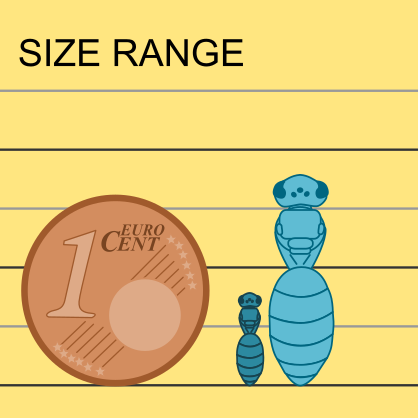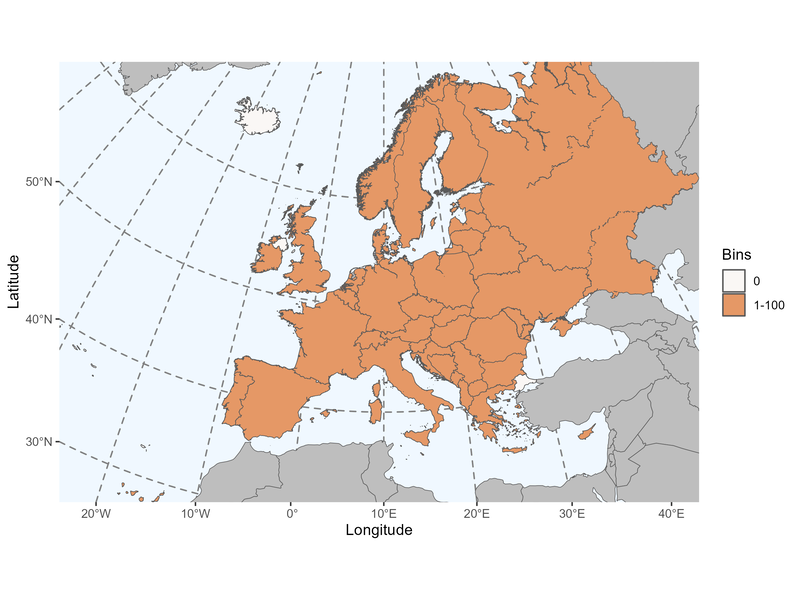Author: Latreille, 1803
|
Type species: Apis pilipes Fabricius, 1775 = Apis plumipes Pallas, 1772, designated by Commission Opinion 151, 1944.
Subgenera: Anthophora s.str Latreille, 1803; Caranthophora Brooks, 1988; Clisodon Patton, 1879; Dasymegilla Brooks, 1988; Heliophila, Klug 1807; Lophanthophora Brooks, 1988; Melea Sandhouse, 1943; Mystacanthophora Brooks, 1988; Paramegilla Friese 1897; Petalosternon Brooks, 1988; Pyganthophora Brooks, 1988 Synonyms: Podalirius Latreille, 1802; Lasius Panzer, 1804; Megilla Fabricius, 1804; Saropoda Latreille, 1809; Micranthophora Cockerell, 1906; Solamegilla Marikovskaya, 1980. |
Clade: Anthophila
Family: Apidae SubF: Anthophorinae Tribe: Anthophorini |
|
Distinctive traits
|
Pictures of distinctive traits.
(Sorry, there is no picture available at this time. If you have some and would like to become a contributor to IDmyBee, please contact us.) |
Morphologically close genera and how to distinguish them:
Amegilla species stend to be smaller with well delimited hairs bands on the metasoma, and lack the arolium.
Habropoda species have a more elongated tip of marginal cell (the apex of the anterior margin of submarginal cell 3 reaches only the middle of the marginal cell), a recurrent vein reaching the apex of submarginal cell 2 and a post-furcal nervulus.
Bombus species have aligned ocelli, never bear yellow-markings on the face and have a vein half-crossing the 1st submarginal cell.
- Anthophora - Amegilla
Amegilla species stend to be smaller with well delimited hairs bands on the metasoma, and lack the arolium.
- Anthophora - Habropoda
Habropoda species have a more elongated tip of marginal cell (the apex of the anterior margin of submarginal cell 3 reaches only the middle of the marginal cell), a recurrent vein reaching the apex of submarginal cell 2 and a post-furcal nervulus.
- Anthophora - Bombus
Bombus species have aligned ocelli, never bear yellow-markings on the face and have a vein half-crossing the 1st submarginal cell.
General comments on Anthophora species identification
Anthophora females can be distinguished using criteria from hairs colour patterns and punctation. Some of the males identification criteria are facial yellow patterns, shape of posterior legs, hairs of the median legs, and may require genitalia comparisons.
Anthophora females can be distinguished using criteria from hairs colour patterns and punctation. Some of the males identification criteria are facial yellow patterns, shape of posterior legs, hairs of the median legs, and may require genitalia comparisons.
Sorry, but the species identification tool is not yet available for Anthophora.
Please check the reference(s) at the bottom of the page for traditional keys.
Please check the reference(s) at the bottom of the page for traditional keys.
|
List of the 78 Anthophora species found in Europe (Ghisbain et al. 2023)
Anthophora (Anthophora) vernalis Morawitz, 1877 Anthophora (Anthophora) canescens Brullé, 1832 Anthophora (Anthophora) crinipes Smith, 1854 Anthophora (Anthophora) fulvitarsis Brullé, 1832 Anthophora (Anthophora) plumipes (Pallas, 1772) Anthophora (Anthophora) punctilabris Pérez, 1879 Anthophora (Anthophora) senescens Lepeletier, 1841 Anthophora (Caranthophora) dufourii Lepeletier, 1841 Anthophora (Caranthophora) pubescens (Fabricius, 1781) Anthophora (Clisodon) furcata (Panzer, 1798) Anthophora (Dasymegilla) quadrimaculata (Panzer, 1798) Anthophora (Dasymegilla) raddei Morawitz, 1875 Anthophora (Heliophila) bimaculata (Panzer, 1798) Anthophora (Heliophila) fulvodimidiata Dours, 1869 Anthophora (Heliophila) lanzarotensis (Tkalců, 1993) Anthophora (Heliophila) lieftincki (Tkalců, 1993) Anthophora (Heliophila) pulverosa Smith, 1854 Anthophora (incertae sedis) laevigata Spinola, 1808 Anthophora (incertae sedis) porphyrea Westrich, 1993 Anthophora (incertae sedis) purpuraria Westrich, 1993 Anthophora (incertae sedis) uniciliata Sichel, 1860 Anthophora (Lophanthophora) affinis Brullé, 1832 Anthophora (Lophanthophora) agama Radoszkowski, 1869 Anthophora (Lophanthophora) atricilla Eversmann, 1846 Anthophora (Lophanthophora) cinerascens Lepeletier, 1841 Anthophora (Lophanthophora) crysocnemis Morawitz, 1877 Anthophora (Lophanthophora) dispar Lepeletier, 1841 Anthophora (Lophanthophora) hispanica (Fabricius, 1787) Anthophora (Lophanthophora) mucida Gribodo, 1873 Anthophora (Lophanthophora) robusta (Klug, 1845) Anthophora (Lophanthophora) rutilans Dours, 1869 Anthophora (Melea) plagiata (Illiger, 1806) Anthophora (Mystacanthophora) borealis Morawitz, 1864 Anthophora (Paramegilla) astragali Morawitz, 1878 Anthophora (Paramegilla) balassogloi (Radoszkowski, 1877) Anthophora (Paramegilla) balneorum Lepeletier, 1841 Anthophora (Paramegilla) deserticola Morawitz, 1873 Anthophora (Paramegilla) dubia Eversmann, 1852 Anthophora (Paramegilla) femorata (Olivier, 1789) Anthophora (Paramegilla) ferruginea Lepeletier, 1841 Anthophora (Paramegilla) fulvipes Eversmann, 1846 Anthophora (Paramegilla) gallica Dalla Torre & Friese, 1895 Anthophora (Paramegilla) gracilipes Morawitz, 1873 Anthophora (Paramegilla) harmalae Morawitz, 1878 Anthophora (Paramegilla) ireos (Pallas, 1773) Anthophora (Paramegilla) larvata Giraud, 1863 Anthophora (Paramegilla) nigrovittata Dours, 1869 Anthophora (Paramegilla) planca Pérez 1895 Anthophora (Paramegilla) podagra Lepeletier, 1841 Anthophora (Paramegilla) ponomarevae Brooks, 1988 Anthophora (Paramegilla) prshewalskyi Morawitz, 1880 Anthophora (Paramegilla) quadricolor (Erichson, 1840) Anthophora (Paramegilla) socia (Klug, 1845) |
Anthophora (Petalosternon) calcarata Lepeletier, 1841 Anthophora (Petalosternon) crassipes Lepeletier, 1841 Anthophora (Petalosternon) orotavae (Saunders, 1904) Anthophora (Pyganthophora) aestivalis (Panzer, 1801) Anthophora (Pyganthophora) albosignata (Friese, 1896) Anthophora (Pyganthophora) alluaudi Pérez, 1902 Anthophora (Pyganthophora) altaica Radoszkowski, 1882 Anthophora (Pyganthophora) atriceps Pérez, 1879 Anthophora (Pyganthophora) atroalba Lepeletier, 1841 Anthophora (Pyganthophora) balearica (Friese, 1896) Anthophora (Pyganthophora) cincrea (Friese, 1896) Anthophora (Pyganthophora) dalmatica Pérez, 1902 Anthophora (Pyganthophora) leucophaea Pérez, 1879 Anthophora (Pyganthophora) monacha (Erichson, 1849) Anthophora (Pyganthophora) nigriceps Morawitz, 1886 Anthophora (Pyganthophora) orientalis Morawitz, 1877 Anthophora (Pyganthophora) pedata Eversmann, 1852 Anthophora (Pyganthophora) pruinosa Smith, 1854 Anthophora (Pyganthophora) retusa (Linnaeus, 1758) Anthophora (Pyganthophora) rogenhoferi Morawitz, 1872 Anthophora (Pyganthophora) romandii Dours, 1869 Anthophora (Pyganthophora) senilis Eversmann, 1846 Anthophora (Pyganthophora) sichelii Radoszkowski, 1869 Anthophora (Pyganthophora) testaceipes Morawitz, 1888 Anthophora (Pyganthophora) ventilabris Lepeletier, 1841 |
References with identification keys for some of the species:
- Friese H. 1897. Die Bienen Europa’s (Apidae europaeae). Theil III. Solitäre Apiden. Genus Podalirius. Berlin, 316 p.
- Osychnyuk A.Z. 1978. Clef de détermination des insectes de la partie européenne d’URSS, Tome III. Hyménoptères. Première partie. Traduction partielle: Superfamille Apoidea (apoïdes). Anthophoridae. Mémoire de fin d’études, Université de Mons-Hainaut, Ecole d’Interprètes Internationaux, 100 pp.
- Herrero Hernandez J. & C.Pérez-Inigo Mora, 1985. Las especies espanolas del género Anthophora (Hym., Apoidea). EOS, Madrid, 61 : 107-145.
- Brooks R.W. 1988. Systematics and Phylogeny of the Anthophorine Bees (Hymenoptera : Anthophoridae ; Anthophorini). The University of Kansas Science Bulletin, 53 (9) : 436-575.
- Rasmont P. 1995. Les Anthophores de France du sous-genre Lophanthophora Brooks avec la redescription de trois espèces au statut confus (Hymenoptera, Apoidea, Anthophoridae). Annales de la Société entomologique de France n.s., 31(1) : 3-20.
- Amiet, F., Herrmann, M., Müller, A., & Neumeyer, R. (2007). Apidae 5: Ammobates, Ammobatoides, Anthophora, Biastes, Ceratina, Dasypoda, Epeoloides, Epeolus, Eucera, Macropis, Melecta, Melitta, Nomada, Pasites, Tetralonia, Thyreus, Xylocopa (Vol. 5). Centre suisse de cartographie de la faune.
- Falk S.J. (2015) Field Guide to the Bees of Great Britain and Ireland. Bloomsbury wildlife guides. 432 p.
Online resources:
Atlas hymenoptera (Europe & Belgium)
BWARS (UK)
Discover Life (World)
WestPalBees (West Palearctic)
Atlas hymenoptera (Europe & Belgium)
BWARS (UK)
Discover Life (World)
WestPalBees (West Palearctic)
Page contributors:
You noticed a mistake? You have a suggestion to improve this page?
Don't keep it to yourself, contact us and become a contributor to IDmyBee!
- Adrien Perrard (Dec. 2023)
- Adrien Perrard (Dec. 2019)
You noticed a mistake? You have a suggestion to improve this page?
Don't keep it to yourself, contact us and become a contributor to IDmyBee!
References used to write this page:
- Bossert, S., E. Murray, E.A.B. Almeida, S. Brady, B. Blaimer, B.N. Danforth (2018). Combining transcriptomes and ultraconserved elements to illuminate the phylogeny of Apidae. Molecular Phylogenetics and Evolution 130 (2019): 121–131
- Ghisbain, G., Rosa, P., Bogusch, P., Flaminio, S., Le Divelec, R., Dorchin, A., Kasparek, M., Kuhlmann, M., Litman, J., Mignot, M., Müller, A., Praz, C., Radchenko, V.G., Rasmont, P., Risch, S., Roberts, S.P.M., Smit, J., Wood, T.J., Michez, D. & Reverte, S. (2023). The new annotated checklist of the wild bees of Europe (Hymenoptera: Anthophila). Zootaxa, 5327(1), 1-147.
- Michener, C.D. 2007. The Bees of the World, 2nd Edition. The John Hopkins University Press, Baltimore.
- Michez D., Rasmont P., Terzo, M., Vereecken, N. 2019. Abeilles d'Europes. Hymenoptères d'Europes, Volume 1. N.A.P. Editions.
- Nieto, A., Roberts, S. P., Kemp, J., Rasmont, P., Kuhlmann, M., García Criado, M., ... & Michez, D. 2014. European red list of bees. Luxembourg: Publication Office of the European Union, 98.
- Rasmont, P., Devalez, Jelle, Pauly, A., Michez, D. & Radchenko, V.G. 2017. Addition to the checklist of IUCN European wild bees (Hymenoptera: Apoidea). Annales de la Société entomologique de France 53: 17-32.



